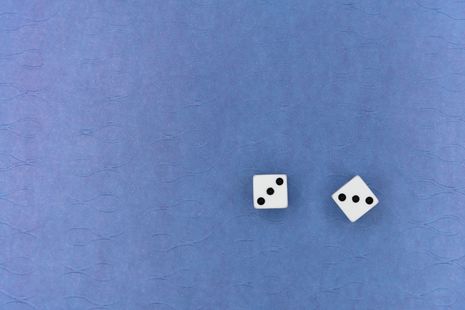Probability puzzles and problems
In this refreshing piece, Nick Scott picks apart some of the world’s most well-known probability problems, inviting readers to have a crack before breaking down the answers

Probability is an area of maths that almost everyone would have studied at school, but still contains many interesting puzzles and results that can surprise even those who have studied the subject at a high level. In this article, I’ve set out some of my favourites, none of which require any advanced mathematics to solve, and have then explained the solutions. I hope you find them as enjoyable as I do!
“I’ve set out some of my favourites, none of which require any advanced mathematics to solve, and have then explained the solutions”
A variant of the Monty Hall problem
I’m assuming many of you have heard of the Monty Hall problem involving a game show with goats behind two doors and a car behind the third, and there are many discussions and explanations of it online (such as this one). Here, I’d like to talk about a slightly different version of the problem.
Imagine you’re taking a multiple choice exam where there are three possible answers to the first question: A, B, or C. You have no idea what the correct solution is, and decide to guess A. An invigilator then walks into the room and announces that B is not the correct solution to the question. Should you switch your answer to C?
The lost boarding pass problem
100 people take turns boarding an aeroplane that has 100 seats. They have each been assigned one of the seats (and no two people have been given the same seat). However, the first person to board has lost their boarding pass and chooses a seat to sit in at random. The rest of the passengers then enter the plane one at a time. If their assigned seat is empty, they sit in it; otherwise, they choose an empty seat at random to sit in.
What is the probability that the 100th person sits in their assigned seat?
Simpson’s paradox
A university realises that it has been accepting a lower proportion of green-eyed applicants than applicants with other eye colours. Since each department of the university runs admissions independently, the university decides to look at each department individually, to see if the disparity is caused by one department in particular. But in fact, it turns out that every department admits a higher proportion of green-eyed applicants than applicants with other eye colours!
Is this possible, and if so, how?
The coin tossing game
Alice and Becky play a game where they toss coins and compete to see who can get the most heads. Alice gets to toss 100 coins and Becky gets to toss 101 (different) coins, but if they get the same number of heads, Alice wins the game.
What is the probability that Alice wins?
Intransitive dice
Suppose you have three dice, which we can call A, B, and C. Each of these is a fair six-sided die with positive whole numbers on each face (a die can have the same number on more than one face). On average, die A tends to beat die B (i.e. if you roll both of the dice, the chance that the value displayed on A is higher than the value displayed on B is greater than 50%) and die B tends to beat die C, but die C tends to beat die A!
Is this possible? If it is, can you find an example?
Turning over cards
Your friend has a standard deck of 52 cards (so there are 26 red cards and 26 black cards), shuffled in a random order. They will turn them over one at a time. At any point, you can stop them; then, they will turn over the next card, and you win if that card is red and lose if that card is black.
If you stop them before they turn over any cards, you have a 50% chance of winning. Is it possible to do better than that?
Answers
A variant of the Monty Hall problem
Unlike in the standard version of the Monty Hall problem, here, whether you switch or not makes no difference to your chances of getting the right answer. The difference between the two scenarios is that in the game show, the host will never reveal that the door you have chosen has a goat, whereas the invigilator did not know which answer you had chosen before they made their announcement.
One way to think about this is to imagine 300 students in the exam, 100 of whom have randomly chosen each of the three options. Suppose the correct answer is actually C. Then the 100 who chose A will benefit from switching, the 100 who chose C will lose out from switching, and the 100 who chose B have to choose either A or C at random. So overall there is no advantage to switching (and no disadvantage from switching either).
The lost boarding pass problem
Surprisingly, the answer is actually 50% (and this is true regardless of how many passengers there are, as long as there is more than one). You can see this without doing any calculations at all by looking at what seats it is possible for the 100th passenger to sit in. It turns out that the 100th passenger will either sit in the seat assigned to them, or the seat assigned to the first passenger (no other seat can be left empty for the 100th passenger, because the person it was assigned to would have chosen to sit in it when it was their turn). Whenever one of the first 99 passengers is choosing to sit in one of the seats, they have the same probability of choosing either of them. This means that the probability that the 100th passenger sits in their assigned seat is the same as the probability that the 100th passenger sits in the seat assigned to the first passenger, and since one of these events has to happen, the probability of each is 50%.
Simpson’s paradox
Yes, this is possible! The simplest example is to suppose that one department is much more competitive than the others, and that green-eyed people are disproportionately likely to apply to that department. Here is an example with two departments:
|
Number of successful green-eyed applicants |
Number of unsuccessful green-eyed applicants |
Number of successful other applicants |
Number of unsuccessful other applicants |
Percentage of green-eyed admitted |
Percentage of others admitted |
|
|
Maths department |
50 |
200 |
5 |
45 |
20% |
10% |
|
English department |
25 |
25 |
80 |
120 |
50% |
40% |
|
University as a whole |
75 |
225 |
85 |
165 |
25% |
34% |
The coin tossing game
The probability that Alice wins is in fact 50%, i.e. Alice and Becky have an equal chance of winning. There are several ways to see this, but my favourite is to imagine that Alice and Becky play the heads game at the same time as the equivalent game for tails. Then if one of them wins the heads game, the other has to win the tails game (think about it!). But heads and tails always have an equal probability of coming up (there is a symmetry in the problem), so the probability that Alice wins the heads game and the probability that Alice wins the tails game are the same. But exactly one of these will happen, so the probabilities must add up to 100%, so the probability that Alice wins the heads game is 50%.
Intransitive dice
Yes, this is possible, and there are in fact many examples. They are called intransitive (or non-transitive) dice because A beats B and B beats C, but A does not beat C (i.e. they do not exhibit the mathematical property known as transitivity). One example is:
A: 3, 3, 3, 3, 3, 6
B: 2, 2, 2, 5, 5, 5
C: 1, 4, 4, 4, 4, 4.
Then A beats B with probability 7/12 (about 58%), B beats C with the same probability, and C beats A with probability 25/36 (roughly 69%).
Turning over cards
Actually, you can’t do better than that simple strategy – and you can’t do worse than it either. The probability of the next card that is turned over being red is the same as the probability of the bottom card in the pile being red (or indeed of any card left in the pile being red, since they are in a random order). But the probability that the bottom card in the pile being red is 50%, since its value is fixed after the cards are shuffled and before any are turned over. So, trying to predict when the next card will be red is like trying to pick when the last card will be red, but the latter is clearly impossible beyond a 50:50 guess.
(You might think that you can just wait until more black cards have been turned over than red ones, and indeed if that occurs, the probability that the next card is red is greater than 50%. But the issue with this strategy is that it is possible for this to never occur (e.g. if the first 26 cards are all red and the rest are black), and the chance that that happens exactly cancels out the gain from adopting this strategy in the situation where it works.)
Hopefully the problems in this article have shown that you don’t need knowledge of advanced mathematics to understand and solve interesting puzzles. I hope you enjoyed thinking about them!
 News / SU stops offering student discounts8 January 2026
News / SU stops offering student discounts8 January 2026 News / Uni-linked firms rank among Cambridgeshire’s largest7 January 2026
News / Uni-linked firms rank among Cambridgeshire’s largest7 January 2026 Comment / Plastic pubs: the problem with Cambridge alehouses 5 January 2026
Comment / Plastic pubs: the problem with Cambridge alehouses 5 January 2026 News / New movement ‘Cambridge is Chopped’ launched to fight against hate crime7 January 2026
News / New movement ‘Cambridge is Chopped’ launched to fight against hate crime7 January 2026 Comment / What happened to men at Cambridge?31 December 2025
Comment / What happened to men at Cambridge?31 December 2025









